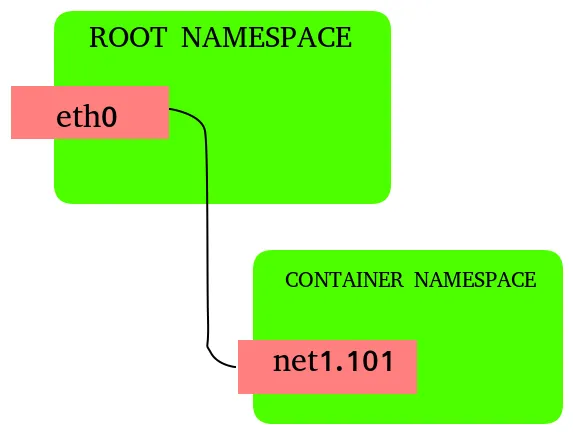Until recently, the existing vlan/macvlan/ipvlan CNI plugins only allowed users to create a VLAN subinterface based on a master interface in the host network namespace, and place the VLAN subinterface inside the container namespace.
Vlan based on node namespaced master
This approach had several drawbacks, the main being issues connected to configuration:
- A preconfigured master interface had to be present on the nodes.
- The vlan/macvlan/ipvlan configuration required knowledge about the node network configuration.
- Multiple network-attachment-definitions needed to be configured to use with different master/vlan combinations. Effectively a single network-attachment-definition could only be used on only one pod.
- The network-attachment-definitions had to be bound to nodes, since the available masters on different nodes could differ.
- The user had to keep track of which master/vlan combinations were already in use.
A recent feature coming in OpenShift 4.13 (Developer Preview) allows the vlan/macvlan/ipvlan interfaces to be configured using container namespace master interfaces.
Vlan based on container namespaced master.
This allows to create the master interfaces as part of the pod network configuration in a separate network-attachment-definition, and base the vlan/macvlan/ipvlan on this interface without requiring the knowledge of the network configuration of the node.
Installing
The feature will be available in OpenShift 4.13 as Developer Preview. No further installation is required.
Configuring a vlan/macvlan/ipvlan with container namespace master
To request the use of a container namespace master interface a new parameter “linkInContainer” has been added to the vlan/macvlan/ipvlan plugin configuration:
{
"name": "mynet",
"cniVersion": "0.4.0",
"type": "vlan",
"master": "eth0",
"mtu": 1500,
"vlanId": 73,
"linkInContainer": true
}
A sample use case for the use of the new feature is to create VLANs based on SR-IOV Virtual Functions. For this a SR-IOV network must be created, followed by the network-attachment definitions for the VLAN interface:
---
apiVersion: sriovnetwork.openshift.io/v1
kind: SriovNetwork
metadata:
name: sriov-network
namespace: openshift-sriov-network-operator
spec:
networkNamespace: mynamespace
resourceName: sriovnic
spoofChk: "off"
trust: "on"
---
apiVersion: sriovnetwork.openshift.io/v1
kind: SriovNetworkNodePolicy
metadata:
name: sriovnic
namespace: openshift-sriov-network-operator
spec:
deviceType: netdevice
isRdma: false
needVhostNet: true
nicSelector:
pfNames:
- ens3f0#0-4
numVfs: 10
priority: 99
resourceName: sriovnic
Followed by a VLAN network-attachment definition:
apiVersion: k8s.cni.cncf.io/v1
kind: NetworkAttachmentDefinition
metadata:
name: vlan-73
namespace: mynamespace
spec:
config: '{
"cniVersion": "0.4.0",
"name": "vlan-73",
"plugins": [
{
"type": "vlan",
"master": "ext0", ⓿
"mtu": 1500,
"vlanId": 73,
"linkInContainer": true, ❶
"ipam": {...}
}
]
}'
Note ⓿: the vlan configuration needs to specify the master name. This can be configured in the pod networks annotation, as shown below.
Note ❶: the linkInContainer parameter must be specified
The pod definition using the above specified networks must use the following networks annotation:
---
apiVersion: v1
kind: Pod
metadata:
annotations:
k8s.v1.cni.cncf.io/networks: '[
{
"name": "sriov-network",
"namespace": "mmirecki",
"interface": "ext0" ❷
},
{
"name": "vlan-73",
"namespace": "mmirecki",
"interface": "ext0.73"
}
]'
Note ❷: The name to be used as the master for the vlan interface.
Use case example
A example use case for this feature is the use of the vlan/macvlan/ipvlan based on SR-IOV virtual functions.
Multiple VLANs can be used with a single virtual function as the master interface. To allow additional configuration the tuning plugin can be used to further tune the created VLAN interfaces. The entire process can be performed in an automated manner, with no knowledge about the node interfaces other than that required to configure the SRIOV plugin.
Status
The TAP device feature will be available in OpenShift 4.13 as Developer Preview.
The use cases for the feature and available options are based on limited customer feedback. Additional feedback on possible use cases and missing functionality are welcome. Please contact your Red Hat account manager for further details.
À propos de l'auteur
Parcourir par canal
Automatisation
Les dernières nouveautés en matière d'automatisation informatique pour les technologies, les équipes et les environnements
Intelligence artificielle
Actualité sur les plateformes qui permettent aux clients d'exécuter des charges de travail d'IA sur tout type d'environnement
Cloud hybride ouvert
Découvrez comment créer un avenir flexible grâce au cloud hybride
Sécurité
Les dernières actualités sur la façon dont nous réduisons les risques dans tous les environnements et technologies
Edge computing
Actualité sur les plateformes qui simplifient les opérations en périphérie
Infrastructure
Les dernières nouveautés sur la plateforme Linux d'entreprise leader au monde
Applications
À l’intérieur de nos solutions aux défis d’application les plus difficiles
Programmes originaux
Histoires passionnantes de créateurs et de leaders de technologies d'entreprise
Produits
- Red Hat Enterprise Linux
- Red Hat OpenShift
- Red Hat Ansible Automation Platform
- Services cloud
- Voir tous les produits
Outils
- Formation et certification
- Mon compte
- Assistance client
- Ressources développeurs
- Rechercher un partenaire
- Red Hat Ecosystem Catalog
- Calculateur de valeur Red Hat
- Documentation
Essayer, acheter et vendre
Communication
- Contacter le service commercial
- Contactez notre service clientèle
- Contacter le service de formation
- Réseaux sociaux
À propos de Red Hat
Premier éditeur mondial de solutions Open Source pour les entreprises, nous fournissons des technologies Linux, cloud, de conteneurs et Kubernetes. Nous proposons des solutions stables qui aident les entreprises à jongler avec les divers environnements et plateformes, du cœur du datacenter à la périphérie du réseau.
Sélectionner une langue
Red Hat legal and privacy links
- À propos de Red Hat
- Carrières
- Événements
- Bureaux
- Contacter Red Hat
- Lire le blog Red Hat
- Diversité, équité et inclusion
- Cool Stuff Store
- Red Hat Summit




